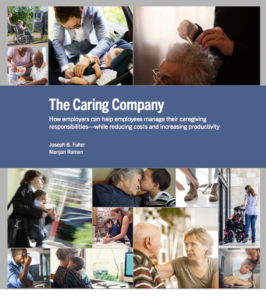American workers must make the most out of their situation when life happens while performing at an optimum level. That’s the corporate ideal, but on a personal level, the burden of caregiving can exceed a worker’s mental fortitude and earning potential. A new report from the Harvard Business School Project on Managing the Future of Work shows companies lose too when workers must decide when to care for a loved one or to keep on working.

“The Caring Company,” from co-authors Joseph B. Fuller and Manjari Raman, suggests companies are ignoring the “silent crisis of caregiving” as it pertains to today’s workers. A rapidly aging population, more women in the labor force and misalignment of benefits are contributing to pressures on work-life balance. For companies that espouse a culture of caring, many are unprepared to expand their conception of caregiving and benefits beyond family leave or more flexible work options.
In the authors’ estimation, companies do not calculate or understand the costs their workers incur when absent from the job or working when distracted or fatigued. High turnover and training costs are hidden from companies’ bottom lines while parents and elder caregivers are acutely aware of what they sacrifice in pay, time and mental strength. The rising cost of child and elder care is eating into earnings, leading workers — mainly women, who still shoulder the majority of caregiving responsibilities — to restrict their careers.
Workers’ expertise leaves with them when they suspend their careers, and many companies aren’t offering a pathway back to pick up where they left off. The result is a miscommunication between the two parties. According to the report, workers suffer in silence and do not utilize their benefits to ease their caregiving burden in fear of negative consequences while companies could look at this underutilization and say that there isn’t a problem. “The Caring Company” illustrates how companies operate in ignorance and pay lip service to caring, while not accommodating a widening spectrum of issues related to care.

The report comes at a time where dynamic population and healthcare trends are coinciding with a labor and skills shortage. WorkingNation talked with the report co-author Fuller over email about how companies can implement a “caring culture” to attract and retain quality workers and maintain continuity in overall productivity and happiness.
WorkingNation: How do we get employers to “walk the walk” about having a “care culture”?

Joseph Fuller: The first step is to provoke more employers to investigate the marginal economics. As more companies figure out that they’re suffering significant productivity losses and turnover, some will develop innovative solutions. Companies mimic best practices. If a few leading companies (not the Silicon Valley types with their hyper-profitability and near monopoly positions) lead the way, others will follow. This study aims to do that by encouraging more employers to ask better questions.
The second is for more employees to make their challenges known. Most employers are responsible, want to be “good” employers, want their people to be motivated and engaged. If workers or groups of workers raise such issues with their supervisors, in employee chat rooms, on sites like The Vault and Glassdoor, some employers will respond.
There is another economic reason for employers to start thinking about this issue — the intense competition for certain types of talent. Let’s use the proverbial example of the digital native/data scientist. They’re in short supply. How does an “ordinary” company attract that type of talent when famous companies with storied brands and sushi bars/masseurs/ping pong tables, etc., want the same talent? How does an employer in Benton Harbor, Michigan, compete for that talent vs. a company headquartered in Boston? Quality of work life. A third-tier auto components manufacturer can’t win vs. Apple for a supply chain specialist based on brand name, compensation and location. But, if they can accommodate the entirety of that person’s life, they could win.
WN: How do we get employers to care more about the nearly one-third who reported difficulties in their work/caregiving duties or get the rest of workers to understand their plight?
JF: The easiest way is, of course, by impressing on them that those difficulties impose costs on them — lost productivity, turnover, etc. Thirty-three percent is a big number. If a technology company approached prospective customers and said “we have a web-based app that will make one-third of your workforce five percent more productive, they’d get a warm reception. The second is to remind them that care events are a feature of virtually every working-aged adult’s life at some time or other. Today’s one-third is different than tomorrow’s.
WN: Why is it important for employers to expand their idea of what caregiving entails?
JF: Employers should be interested in the effects, more than the causes. As an employer, I want my workforce to be productive and I want to reduce voluntary turnover (especially in hard-to-fill jobs, especially in tight labor markets, especially for experienced/senior/high-value-added workers). If they are oblivious as to why someone is suffering from presenteeism or resigns, they can’t address it.
Understanding that caregiving goes far beyond maternity/adoption — which is still the single biggest care event in terms of driving turnover — and knowing what their organization’s care demographics are allows an employer to make an informed choice as to whether they want to make some sort of additional investment/expenditure to reduce those costs like on-site/shared site child care or providing a yearly credit at a service like Care.com for last minute needs or subsidizing some forms of elder care. I think maternity/adoption gets lots of focus because it’s become a political issue and may become statutory. But the other types of care events have the exact same type of consequences; they’re just not nearly as apparent.
WN: Would employers say that this opens a Pandora’s box of excuses that make a solution impossible to deliver for the highly personal decisions/strategies their caregiving employees must make?
JF: I can imagine employers throwing up their hands and saying “we’re not responsible for employees’ lives outside the work day.” That’s true. I’m just saying that their lives show up in your workplace every day and employers ought to understand the spillover effects.
I similarly am suspicious of general solutions as offered by or mandated by governments. Employers have different workforce demographics with different care profiles. They have more or less difficulty filling jobs. They have different levels of access to care services/infrastructure based on location, etc. Governments for obvious reasons opt for low common denominator solutions — so they’re much more likely to legislate “full-day preschool for all” because it benefits a huge number of people vs. “we’ll fund a cognitive disease unit in our town/city senior center,” which benefits far fewer people.
RELATED: Home care providers need the support they deserve
If the question is “aren’t a lot of these situations unique and there aren’t many low common denominator solutions,” I’d say no. There are a limited number care events that emerge in a lot of people’s lives — maternity/adoption, early childhood care/development, a child with some form of chronic condition, a spouse who has a chronic condition/an illness/is disabled, seniors that need living support or suffer from cognitive impairment. Those are the big ones. Yes, the disability affecting a spouse could be anything from substance abuse to a physical injury, but the Pareto principle applies. You can address 80 percent of the causes of presenteeism and turnover by accounting for 20 percent of the phenomena.
WN: Will the decentralization of work ultimately benefit caregivers in the long run?
JF: To a degree, yes. But working remotely doesn’t “work” for lots of types of positions. And, it works best as a temporary measure for a full-time employee following a career path with upward mobility in the organization. So, you can have customer service representatives who work at their kitchen table while their kids are at school, or digital designers, or the types of workers that are accessible through outfits like Upwork. And services like Thumbtack and Care.com provide some workers with more flexible working arrangements that, in turn, may allow them to sculpt their employment/source of income to their personal circumstances.
Remember that caregiving obligations are different — some are temporary, some are long-term. I suppose one could create a map of the intrinsic nature of work and contrast it the manifestations of the care responsibility as it relates to work.
WN: What do you think the rise of caregiving burdens has on the growth of freelancer culture?
JF: A big one! Especially as it relates to single parents, especially as it relates to women who are unable to/ambivalent about working outside the home during child raising years.

As the report indicates, a huge issue for companies is female workforce participation. More jobs require college/post-graduate degrees. That talent is “sold out,” and demand outstrips supply for workers with certain backgrounds (specific skills, degrees from highly competitive institutions, etc.). An outright majority of college enrollees and graduates and post-graduate enrollees and graduates are women. Women’s workforce participation peaked 20 years ago and has been falling. Employers are going to need to make it easier for women to either stay in their employ or to accommodate their desire to strike a work/life balance.
RELATED: Degree inflation holds back workers and employers
There’s an obvious chicken and the egg phenomenon here. Technology is allowing more remote work, which allows workers to make different choices about work-life tradeoffs. The need to find means of making a living while accommodating care obligations is causing more people to provide for themselves by engaging in remote/gig work. The option of doing remote/gig work is an important driver of the type of voluntary turnover that care obligations cause and that is so costly to employers.
This conversation was edited for clarity.
To get a sense of the uphill climb professional home healthcare workers must face with low pay and increasing demand for services, watch our Do Something Awesome video about the Paraprofessional Healthcare Institute (PHI) and their work to improve standards and pay.
Join the Conversation: Tell us your story of how caregiving burdens affected your job on our Facebook page.











